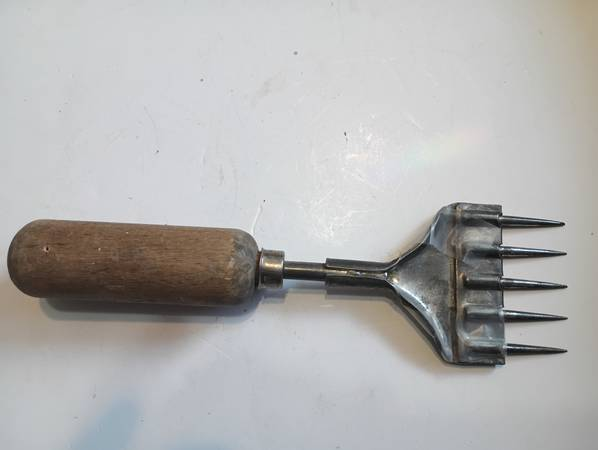An Unexpected Find in the Middle of Cleaning
While cleaning out my mom’s room, I came across something that made me stop in my tracks. Tucked away in a dusty corner was a strange-looking tool with a green wooden handle and three sharp metal points. I picked it up, turned it over in my hand, and tried to imagine what it could be.

It was heavier than it looked, and the design seemed intentional — one straight point in the middle, flanked by two curved hooks. My first guess? Maybe it was some kind of old farming implement, something used for digging or pulling crops. But I wasn’t sure, so I did what anyone would do — I took a picture and asked the internet.
The Surprising Answer
The responses came in fast, and the truth was far cooler (literally) than I expected. This wasn’t a farming tool at all — it was an old-fashioned ice pick and chipper, a common household and commercial item before the days of modern refrigerators and ice makers.
Back in the early to mid-20th century, ice didn’t come from a freezer in convenient cubes. People bought it in massive blocks, delivered by icemen and stored in insulated iceboxes. This tool was designed specifically to break those giant blocks into usable chunks for home use.
Video : Briddell Ice Pick No. 60 Antique Kitchen Utensil Demo
How It Worked
The design was as clever as it was practical. The single pointed prong in the center was used to chisel and split ice. By striking the point into the surface of a block, you could crack it into smaller pieces. The two curved hooks on either side served another purpose — they acted as grips for pulling or lifting chunks of ice out of the container or icebox.
This combination made the tool essential in kitchens, bars, and ice shops. Bartenders used them to create the perfect size ice for cocktails, while families used them daily for food storage and drinks.
A Glimpse Into Life Before Refrigeration
Before electric refrigerators became standard, the icebox was the centerpiece of kitchen preservation. Delivered ice would be packed inside, keeping food cold for days. Tools like this three-pronged chipper were part of daily life, just as common then as an ice tray or ice dispenser is today.

It’s easy to forget how much effort went into something as simple as having ice in your drink. From harvesting frozen lakes in winter to shipping and delivering blocks, and finally breaking them down at home — it was a process that involved skill, strength, and specialized tools.
Other Uses for This Tool
While ice was the main purpose, some similar designs also found their way into farms and markets. The prongs could be handy for lifting root vegetables like turnips or potatoes from storage piles. Still, the three-pronged style with a sturdy handle was most famously associated with ice handling.
Why Finds Like This Matter
Holding this tool today feels like holding a tangible piece of history. It’s not just metal and wood — it’s a reminder of a time when daily life required more hands-on effort, and even something as small as a cool drink on a summer day involved a bit of work.
It’s also a nod to craftsmanship. These tools were built to last, often surviving decades of use without breaking. The fact that this one was sitting in my mom’s room, still solid and intact, proves just how durable and well-made they were.
Video : IC78 Ice Chipper FSW for Youtube
Conclusion
What started as a random discovery turned into a fascinating lesson in everyday history. That odd-looking, three-pronged device turned out to be a vintage ice pick and chipper — a kitchen essential from an era before electric refrigerators. More than just a tool, it represents ingenuity, tradition, and the ways people adapted to make life easier with what they had.
Next time you stumble upon an unusual old object, remember — it might just be a story waiting to be told. And sometimes, those stories are cooler than you could ever imagine.